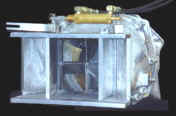|
Company History
The development of
IntelliJet Marine, Inc. began when current president, Jeff
Jordan, was considering the purchase of a manufacturer of aluminum jet
river boats. Mr. Jordan had previously spent ten years in the design and
manufacture of small commercial hydroelectric systems, during which time
he observed several causes of hydraulic inefficiency in the marine jet
propulsion systems.
Any such cause of
inefficiency is rigorously attacked in the hydroelectric business
because it translates into power not generated and revenue lost. In jet boats it translated
into the need for a flatter hull, a bigger motor and a bigger fuel tank.
In jet boats
(inefficiency) translated
into the need for a flatter hull, a bigger motor and a bigger fuel tank.
The application of
hydroelectric design principles to jet boats resulted in three broad
patents covering the inlet, pump and nozzle control conditions that must
be maintained for efficient marine jet propulsion.
|

The
Variable Nozzle
The
variable rectangular steering nozzle allows simultaneous control
of nozzle area and steering direction to maintain peak efficiency
over wide ranges of boat speed, pump shaft speed and steering
vectors.
Back
to Top |